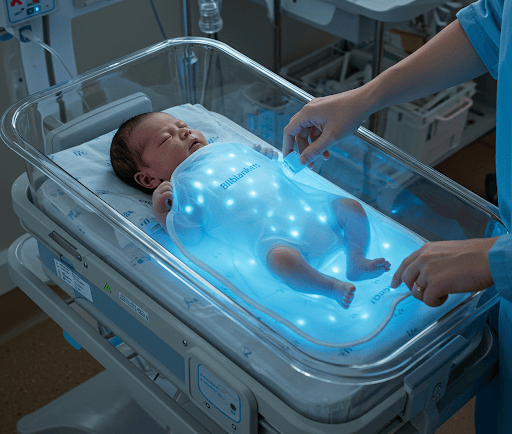Biliblankets: A Breakthrough in Neonatal Jaundice Treatment
Neonatal jaundice is a common condition that affects many newborns, characterized by an excess of bilirubin in the blood. If left untreated, severe jaundice can lead to complications such as kernicterus, which can cause long-term neurological damage. Traditionally, phototherapy using overhead bili lights has been the primary treatment for neonatal jaundice. However, recent advancements have introduced biliblankets, a revolutionary solution that enhances treatment efficiency while allowing for greater parental bonding and home-based care.
4/3/20253 min read


Understanding Biliblanket Technology
Biliblankets utilize advanced fiber-optic technology to deliver phototherapy directly to the infant’s skin. Unlike conventional overhead bili lights, which require the baby to remain stationary under a light source, biliblankets consist of a flexible, light-emitting pad that can be wrapped around the baby. The light penetrates the skin, breaking down bilirubin into a water-soluble form that is easily excreted through urine and feces.
The biliblanket emits blue light within the optimal wavelength range of 420–470 nm, which is the most effective for bilirubin breakdown. This targeted approach ensures continuous treatment without disrupting feeding and bonding activities, offering a more convenient and comfortable option for parents and newborns alike.
Advantages of Biliblankets Over Conventional Phototherapy
Enhanced Mobility and Comfort: Unlike traditional phototherapy, which requires babies to be separated from their caregivers, biliblankets allow parents to hold, feed, and care for their infants while treatment is ongoing.
Home-Based Treatment Option: Biliblankets enable jaundice management at home, reducing the need for prolonged hospital stays and lowering healthcare costs.
Continuous and Uninterrupted Therapy: With conventional bili lights, phototherapy is often interrupted for feeding and care. Biliblankets ensure that treatment continues seamlessly without major disruptions.
Reduced Risk of Dehydration and Hypothermia: Since newborns remain clothed while using biliblankets, they are less susceptible to dehydration and temperature fluctuations that can occur with overhead bili lights.
Parental Involvement in Care: By enabling in-home treatment, biliblankets empower parents to take an active role in their child's care while reducing the stress associated with hospital admissions.
Clinical Efficacy of Biliblankets
Multiple studies have confirmed the efficacy of biliblankets in reducing bilirubin levels in neonates. A clinical trial by Ebbesen et al. (2004) found that biliblankets were nearly as effective as conventional phototherapy in treating mild to moderate neonatal jaundice. Additionally, research by Tan (1996) highlighted that continuous phototherapy using a biliblanket achieved significant reductions in bilirubin levels within the first 24 hours of treatment.
Limitations and Considerations
Despite their advantages, biliblankets are not suitable for all cases of neonatal jaundice. Severe jaundice may still require more intensive treatment in a hospital setting, including exchange transfusions if bilirubin levels become dangerously high. Additionally, some studies suggest that biliblankets alone may be slightly less effective than overhead phototherapy for severe hyperbilirubinemia, necessitating combined approaches in some instances.
Other considerations include:
Initial Cost: Biliblankets can be more expensive than conventional phototherapy equipment, though the reduced need for hospital stays may offset this cost.
Availability: Not all healthcare facilities or home healthcare services may have biliblankets readily available for outpatient use.
Parental Education: Parents using biliblankets at home require guidance on proper usage and monitoring to ensure treatment efficacy.
Best Practices for Using Biliblankets
For optimal results, caregivers should follow these guidelines:
Ensure the light-emitting pad remains in direct contact with the baby’s skin.
Monitor bilirubin levels regularly as directed by a healthcare provider.
Watch for signs of worsening jaundice, such as deepening skin discoloration or lethargy.
Maintain adequate hydration through frequent feeding.
Follow up with pediatricians to determine when phototherapy can be safely discontinued.
Conclusion
Biliblankets represent a significant advancement in neonatal jaundice treatment, providing an effective, non-invasive, and parent-friendly alternative to traditional phototherapy. Their ability to facilitate continuous phototherapy while allowing for normal infant care and bonding makes them an invaluable tool in modern neonatal care. As technology continues to evolve, biliblankets are expected to play an even greater role in the management of neonatal jaundice, improving outcomes and enhancing the quality of care for newborns and their families.
References
Ebbesen, F., Agati, G., Pratesi, R., & Rigato, F. (2004). "Efficacy of Biliblanket in Treating Neonatal Jaundice at Home." Pediatrics, 113(2), 156–160.
Maisels, M. J. (2015). "Phototherapy for Neonatal Jaundice: An Update." Seminars in Perinatology, 39(3), 239–244.
Tan, K. L. (1996). "Comparative Efficacy of Biliblanket and Conventional Phototherapy in the Treatment of Neonatal Jaundice." Journal of Pediatrics, 128(5), 658–660.
